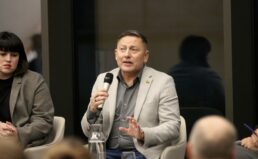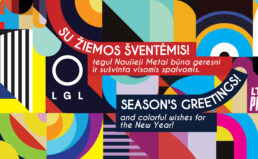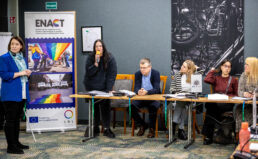Nowadays a gay club in Vilnius is not a surprise to anyone and it is visited not only by sexual minorities. Even the mayor of Vilnius Remigijus Šimašius visited the gay club “Soho” before the second round of municipal elections. 20 years ago the situation in the country was different – LGBT community’s parties took place in secret and to avoid violence sometimes their locations had to be changed. However, despite that, they were visited by Lithuanian and sometimes even world-class music stars.
Vladimir Simonko, Executive Director of LGL, and Eduardas Platovas, former editor of a magazine for homosexual people “Amsterdamas” agreed to tell 15min about how Lithuanian homosexual people had fun at the end of the 20th century and how clubs for members of sexual minorities were being created.
Everything began with a house in Nemenčinė
After restoration of independence the community, which only existed underground back then, since homosexuality was decriminalized only in 1993, started looking for gathering spaces.
The first of them, according to E. Platovas, was just a private house behind Nemenčinė, where in the summer evenings of around 1993-1994 LGBT community’s discotheques took place.
Everything was self-organized here – the equipment was just a few speakers connected to cassette players that music was played through, and the bar was just a window where you could get vodka with juice.
Finally, according E. Platovas, these surroundings got boring and it was decided to rent a space for community’s parties in Vilnius. Finally a suitable place was found in the very city centre, in the Technical library.
“I remember how me and Eduardas went there and said that we wanted to organize an evening, but we couldn’t admit what sort of evening it was going to be. And the rules where that when renting the place you also had to take the food, all sorts of salads with herring, because otherwise it wasn’t worth it. And everything was prepared”, – V. Simonko smiles.
However the secret wasn’t kept from the owners for a long time. When the day of the party came, V. Simonko brought the music equipment and after all decided to tell the owners what kind of a party it was going to be.
“But the owners reacted okay. And afterward they saw that we’re very fun and interesting and we continued that cooperation”, – said V. Simonko.
The first party in the Technical library, according to E. Platovas, happened on December 3, 1993. LGL now considers this the first day of their organization’s work.
Around 50 people came to the first party. “It was good for the first party, after all “Facebook” didn’t exist back then and you couldn’t find information so easily. Everything that existed was a physical phone book and landline phones”, – remembered E. Platovas.
Open to everyone
Later on the parties were still happening. They were visited not only by locals – some homosexual partygoers came from expats, living in Riga or Vilnius. Besides that, heterosexuals also were frequent visitors: ‘’We were the only spot, where you can go and party at night. Therefore, we can take some credit for the development of the nightlife in Vilnius. Before that there were only expensive restaurants, which were popular among the mafia’’ – says E. Platovas. While becoming more popular among the people, more space was needed – the LGBT community parties started taking place in the basement of the Palace of the Trade Unions. In that building, various organizations and groups found their safe haven. The club also got a name – ‘’Amsterdamas’’, just like the LGL magazine at the time.
‘’Amsterdamas’’ did not have a fixed place – it changed for a few times. Although, V.Simonko told that they tried to organize the parties at the same place, due to security reasons, often the parties had to be held in a different location.
From 1995 to 1996, in J. Basanavičius street they have tried to open up a café, but it only existed for a year: ‘’We were making enough money only for the rent. The whole process was quite challenging. There was a lot of hate, even some hate crimes were committed against us’’, remembers V. Simonko.
Popular places to meet people of the same orientation were not limited to clubs only. Café ‘’Opera’’ near the National Opera and Ballet Theatre and the theatre was one of the favourite places to meet others. Also, meetings took place in the café ‘’Akimirka’’, which was located in Gediminas avenue at that time. Searches continued in the Lukiškės square as well, shares V. Simonko.
Did an earring help to find other members of your community? V. Simonko tells, that the answer is yes, but there were some important nuances: ‘’It was dangerous, since many gangs would beat up people, who were looking strange to them’’.
From the biggest concert hall in Vilnius – to the gay club
Underground gay parties attracted foreign celebrities as well. One of the parties held in the Palace of the Trade Unions was visited by the leader of synthpop group ‘’Bronski Beat’’ Jimmy Sommerville.
At the end of the 20th century the music of ‘’Bronski Beat’’ was popular not only among the the homosexuals. Many young people all across Lithuania danced along to ‘’Smalltown Boy’’.
‘’Bronski Beat’’ were invited to Lithuania by a radio station ‘’Radiocentras’’. In Vilnius Concert and Sports Palace the station was hosting their birthday concert and one of the headliners were ‘’Bronski Beat’’.
‘’This was an interesting story. We knew, that he was coming. We thought – why not to write to him? We wrote to him, he wrote back. We asked, whether he would agree to perform in our club. Right now I could not do something like this, but at the time it seemed so easy. He agreed. To this day I remember when Arnas Klivečka called and said – what is happening, we are bringing him here and paying for him, and you invite him just like that?! After that, ‘’Radiocentras’’ rhetorically asked on air – do you know where Jimmy Sommerville will go out?’’ – laughs V. Simonko.
J. Sommerville was not the only international celebrity, who visited Lithuanian Gay League parties. In 1994, men ballet troupe ‘’Les Ballets Trocadero de Monte Caro’’, who perform parodies of classical ballet, visited Lithuania. The troupe performed in the National Opera and Ballet Theatre.
‘’Almost all of the troupe members were homosexuals. After their performance we gave them flowers. I will not tell, who gave them flowers, since I think that the person is still hiding his orientation, however, you can often see him on television. Then he was working in the theatre and took this responsibility. We bought a basket of flowers and placed an invitation in English to the basket. And they came, the whole troupe’’, shared V. Simonko.
According to the director of LGL, the community was very happy to see so many handsome men from abroad. When the troupe left for Saint Petersburg, three or more Lithuanians left with them. ‘’Some of them created beautiful lives together. It was some sort of a window to the world’’, said V. Simonko.
Parties in Kaunas were stopped by a tragic ending
A bit later, closer to the millennium, the gay bar had opened its’ doors in Kaunas. The name of the bar was ‘’Mefistofelis’’. The bar was located in a private home in Kalniečiai and the main action was held in a garage. According to E.Platovas, the parties around the year 2000, were bigger than in Vilnius.
‘’Džordana Butkutė loved to visit the bar. A frequent visitor was also a very popular singer, I will not give out names, but you know him. He is from Kaunas. And he did not leave the city. Now he has a family, even a child, and is very secretive about his orientation’’, tells V. Simonko.
However, the story of the bar is quite unfortunate. As LGL director says – the owners of the bar were a couple – an older and a younger partners.
‘’They were hosting parties for a long time. However, when the older partner died, his family kicked the younger partner out of the house and he was left with nothing. It was a long-lasting partnership with a tragic ending’’, shared V. Simonko.
After that, next to Soboras another club was opened – ‘’Kapeika’’. And in Klaipėda, Šilutės highway, ‘’Naktinė ledi’’ was opened. This club was very popular during summers, when a big part of Lithuanian LGBT community moved to Palanga.
Life is better, but less clubs
V. Simonko and E.Platovas draws attention to an oxymoron – now, when the life of the LGBT community is become better and easier, the number of gay clubs is significantly lower than ever before.
Here in Vilnius there is an only LGBT club, which is open for only two days a week. However, Lithuania is not special, when talking about LGBT nightlife.
‘’There is a tendency in the Western states – social media and dating applications speed up the meeting process and takes away the partygoers. Clubs are also closing down in the Western states, they just do not have as many people as they used to’’, says V. Simonko.
He is also hoping for a café, which would be exclusive to the LGBT community in Lithuania. An abundance of such cafes could be found in Paris, London or Barcelona. Although there are many cafes in Lithuania, which are LGBT friendly, it is not the same, according to V. Simonko. ‘’Of course, it is good, but sometimes you just want to be around your community. There are no cafes, where more than 50% of the visitors are the same orientation as we, no specific music or decorative choices’’, shares V. Simonko.
According to the interviewees, one of the reasons why there are no clubs or cafes, is a massive emigration of the LGBT community. ‘’Athough ‘’Baltic Pride’’ attracts many people, you can see that a big part of our community is now living abroad. Now, that you can register your partnership or get married in other states, people solve the lack of such rights just by leaving Lithuania. The state is not even thinking about this’’, says E. Platovas.
‘’Recently we were invited to our friends’ wedding in London. One is a citizen of the United Kingdom, the other will probably become one quite soon. Among the other guests were a lot of emigrants, who are not even thinking about coming back. We can fight throughout all of our lives, but many choose a different path’’, adds V. Simonko.
At the end of conversation, the director of LGL acknowledges – although life at the end of the 20th century was challenging and hard, there were some beautiful moments. ‘’We were doing everything not seeking for profit, rather, we worked since we believed in our ideas. We tried not to go bankrupt, but we did not made millions. Of course, it is fun to remember everything. I doubt that young people today can understand the underground and the beauty of it’’, says V. Simonko.




